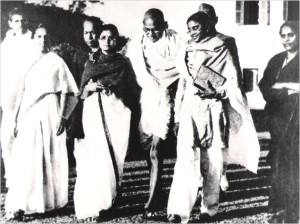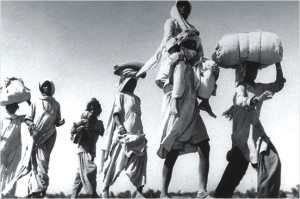
Inside
|
Oh, these sixty years! Sixty years on from partition, MB Naqvi draws up the balance sheet and examines what the Muslims of the Indian sub-continent have gained and what they have lost
This partition changed little in what used to be West Pakistan. In a rather superficial enumeration of forces, one has to count the communal riots that preceded and followed independence. The severity and barbarism of this ethnic cleansing was a new thing, while one originally had a different concept of what a communal riot was: a few dozen people, armed with lathis and soda-water bottles, and some with knives, facing another few dozen similarly armed. Sometimes a few heads were broken and sometimes someone brokered a settlement. The communal riots took place off and on in India and in the eastern province of Pakistan. These were quite deadly. Even the technology used has evolved over time. Earlier, the police used to wave their batons and the two clusters of rioters would disappear. What a long distance these riots have traveled since 1947, when hundreds of thousands died, and millions had to
The more important point is, what has communalism, the outstanding shaping force for all three countries, achieved? India of course had the benefit of a large, well-organized party, Congress, led by a man like Jawaharlal Nehru, a Fabian socialist and a man of vision. But he was primarily a nationalist and a secular person. He tried to take India along the path of secularism, and the country did travel the secular path for some time. But the forces of Hindu communalism were too strong for it, and at no stage of Nehru's glory years was the share of the Hindu communalist vote in cities and larger towns less than 30 per cent. That Congress won election after election is true. But in all the urban constituencies, in the north at least, it had Hindu communalists to contend with, and a few Hindu communalists did enter Indian politics from time to time. Later, of course, they even became a majority by associating small caste-based parties, and ruled India for six year in all. How does India fare? India has a first rate capitalist economy, developing at quite a high rate of growth. Its middle classes number about 300 million, larger than most countries constantly in the news. It is an industrialized country. It has the fourth largest military strength in the world. It is a country where social inequalities are increasing, and the rapidly growing prosperity remains confined to its middle classes. Communal forces are strong and have consolidated. The Hindutva-supporting political parties have, more or less, an ally in Big Business; the Indian bureaucratic and scientific establishments are sympathetic to Hindutva parties, and, of course, all the communal elements are with them. It still remains a force though it is Congress that is ruling.
Insofar as Pakistan is concerned, it is firmly ruled by the army. Ever since the military took over formally in 1958, and informally from 1953 onward, it has called all the shots. The forces that are operating in Pakistan comprise a large number of right-wing parties, all mouthing Islamic rhetoric. The party with the least Islamic rhetoric, and thought to be most secular, is Benazir Bhutto's PPP. She is both a secular nationalist and also rather coyly proud of PPP's Islamic character. It refuses to be called secular but is regarded as secular. But it is primarily a populist party. Today, it is as conservative in composition as it is in its aims. Its foreign and economic policies do not differ from Musharraf's. Even PML (N) of Nawaz Sharif does not differ in foreign policy or economic policy with Musharraf, though Nawaz is personally dead-set on sending the army to the barracks. What the outlook is, is hard to say, because the extreme right-wing comprising the Islamic parties, is so strong, and is becoming stronger daily as a result of Musharraf's ability to play both sides of the street. Today he faces a dilemma: from the outside, the Americans are growling that Pakistan is not suppressing the Islamic militants, particularly the Taliban; it is required by Americans to prevent Taliban from crossing over into Afghanistan to do battle with Nato and other coalition forces. Internally, he is facing political opposition from PPP and many others. But all observers think that Benazir, given a chance, would do a deal with Musharraf. There is also a bogus polarization between Musharraf and the six religious parties' alliance called Muttaheda Majlis Amal (MMA). All said and done, the army's power is not really threatened. Insofar as Bangladesh is concerned, it has hard to say what will emerge. It has the same fault-line of communalism between the Hindus and the Muslims. It has, apparently, few Leftist parties, but they are determined ones. There are two mainstream, middle-class parties, both nationalist, the BNP and AL. AL has a secular outlook and espouses a secular Bengali nationalism. The BNP, a successor to the old Muslim League, talks of a Bengali Muslim nationalism. There is very little difference in economic and other policies between the two parties. But on the secularism question, the BNP is more Islamic than secular. What the outcome of the contest between AL and BNP will be is hard to say: it is an old contest that has not yet ended. One wonders what the Muslims of the sub-continent have gained from espousing communalism since way back in the 19th century. The Muslims of the sub-continent, as Chaudhry Khaliquzzaman told this writer in 1972, stand divided into three parts. Among these three units of Muslims, none of them has a third of the influence that united Muslim India used to before 1947. The partition of India meant leaving alone the Indian Muslims whose number was roughly close to those of the Muslims in Pakistan. Even today the Muslims in the three countries are roughly equal in numbers, but each face more problems today and have less influence. Muslims in Bangladesh and Pakistan think they are an important part of the Islamic world. But is the general condition of the common Muslims in any of the three countries, one wonders, any better today than what it might have been in an undivided India? What price did the common people, Muslims especially, pay for the various partitions. Has anyone benefitted by departing from the idea of a pluralistic and democratic society? Instead of emphasizing the need for democracy, social welfare, and freedoms, the old Indians decided to talk about the wonders of being Hindus and the glories of being Muslims. It is time that a balance sheet was drawn up. MB Naqvi is an eminent Pakistani columnist. |

 There were other factors in the field. There was the process of economic development in India, of the kind that Nehru dictated, that gave India a firm foundation of basic industries on top of which further development became easy. In Pakistan we had accretions of ad hoc factories and mills, unrelated to one another and not forming part of any self-sustaining integrated industrialization. Bangladesh has seen some economic development after independence, though in Pakistan years it had some jute industries and a few textile mills. The pools of poverty in all three countries are quite large, and it is hard to say where one would find the dirt poor. The intensity of poverty is hard to measure precisely for the three countries. But it is fair to say that it is all quite regrettable.
There were other factors in the field. There was the process of economic development in India, of the kind that Nehru dictated, that gave India a firm foundation of basic industries on top of which further development became easy. In Pakistan we had accretions of ad hoc factories and mills, unrelated to one another and not forming part of any self-sustaining integrated industrialization. Bangladesh has seen some economic development after independence, though in Pakistan years it had some jute industries and a few textile mills. The pools of poverty in all three countries are quite large, and it is hard to say where one would find the dirt poor. The intensity of poverty is hard to measure precisely for the three countries. But it is fair to say that it is all quite regrettable. But India has two main fault-lines. One is the old and steady: the communal one. The second is between the Left and Right. India's Right is actually divided between the Congress and the Hindutva parties at one plane, while the Left is splintered into a dozen or more parties and groups. Congress itself is divided between the Rightist and vaguely Leftist tendencies. There are three or four parliamentary Left parties, while four or five are Maoists groups that use violent means. As noted, the Right in India is divided between Congress and BJP, while the secular elements are mainly in the Congress, but a few are outsiders for both. In terms of communal versus the secular, all the Left is secular. What the upshot would be is hard to say.
But India has two main fault-lines. One is the old and steady: the communal one. The second is between the Left and Right. India's Right is actually divided between the Congress and the Hindutva parties at one plane, while the Left is splintered into a dozen or more parties and groups. Congress itself is divided between the Rightist and vaguely Leftist tendencies. There are three or four parliamentary Left parties, while four or five are Maoists groups that use violent means. As noted, the Right in India is divided between Congress and BJP, while the secular elements are mainly in the Congress, but a few are outsiders for both. In terms of communal versus the secular, all the Left is secular. What the upshot would be is hard to say.